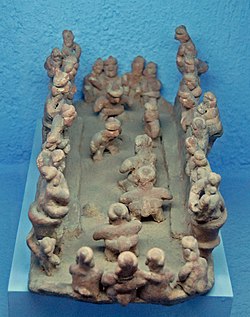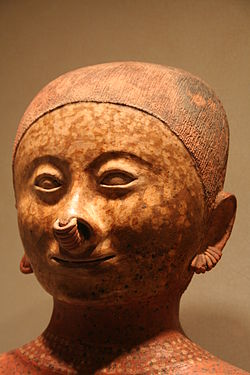Shaft grave tradition
The terms shaft tomb traditionor more appropriately, shaft or shaft tomb culture refer to a set of features of an ancient pre-Hispanic culture which has been found in the Mexican states of Nayarit, Jalisco, Colima, the Zamora-Jacoma area of Michoacán, southern parts of the states of Sinaloa and Zacatecas. It has been dated between the years 300/200 a. C. and 400/600 d. C. A good part of the objects produced by the peoples of this culture have been found out of archaeological context, due to the activity of tomb robbers whose trousseau had been sold on the black market. One of the largest burials associated with this tradition was found in 1993, in Huitzilapa (Jalisco).
Although at first the ceramics of the shaft tombs were associated with the Tarascans, contemporaries of the Mexicas; around the middle of the 20th century these objects were discovered to be at least over a thousand years older. Until relatively recently, all that was known of the peoples of the shaft tomb culture were ceramic objects and that they buried their dead in galleries dug into the ground (hence the name of this culture). Almost unknown until then, the largest collection of classical ceramics from Western Mesoamerica was presented in 1998, with the subtitle Art and Archeology of the Unknown Past. Today it is known that the culture of shaft tombs does not characterize a single cultural area, although many archaeologists continue to identify the peoples who lived in western Mesoamerica during the Preclassic and Classic periods by this name.
The graves
The so-called shaft tombs are characteristic burials of certain archaeological sites in Jalisco, Nayarit, Colima and Michoacán, in Mexico, although they also appear in places in South America such as Colombia or Ecuador. They are considered to belong to the so-called Shaft Tomb Culture, which is estimated to have developed between the years 200 B.C. C. and 600 d. c.
Structure
They consist of a shaft or well between 2 to 20 meters deep with a circular or rectangular section that is dug into the ground. Upon reaching a certain depth, one or several burial chambers are excavated to one side that will contain the corpse and its offerings. These chambers are connected to each other with small tunnels in which ceremonial elements that accompanied the dead have been found. Once the burial is done, the communication between the chamber and the well or shaft is closed, the shaft is filled with earth and, in general, no trace of the grave remains. Variations between graves may be due to the quality of the subsoil, the social category of the person or persons buried, or simply the style of fashion in a certain area or at a certain time. In general, shaft tombs usually house several bodies.
Studies of the pieces contained in the tombs and some carbon-14 dating indicate that their use covers a period from shortly before Christ until the year 400. Some of the tombs are very complicated and have several burial chambers.
Distribution
The most recognized shaft tomb is that of Etzatlán, with three chambers and 16 meters deep.
Apart from their presence in western Mexico, this type of tomb also exists in places in South America. They are particularly abundant in the area of Ecuador and Colombia. This fact and other cultural traits that coincide between western Mexico and this region of South America tend to indicate ancient relationships between these two distinct areas.
Offerings
The offerings consisted of ceramic pieces with representations of men or women in some activity, as testimony of the way of life they had led (hunters, musicians, farmers with their belongings and clothing). There were also everyday or ornamental pieces and his nahual, companion on the journey to the underworld, costume of the god of death, who leads or guides the soul of the dead through the nine torrents that separate the deceased. from the sky. This nahual was an animal that could be a parrot, a duck, or a snake, although it was usually a dog: these animals popularly became the bald dogs or izcuintli, figures very representative and known as the emblem of Colima, of which there are similar figures in the Mochica culture of Peru.
Contenido relacionado
Statue of Liberty
Inca empire
Chrysler Building


